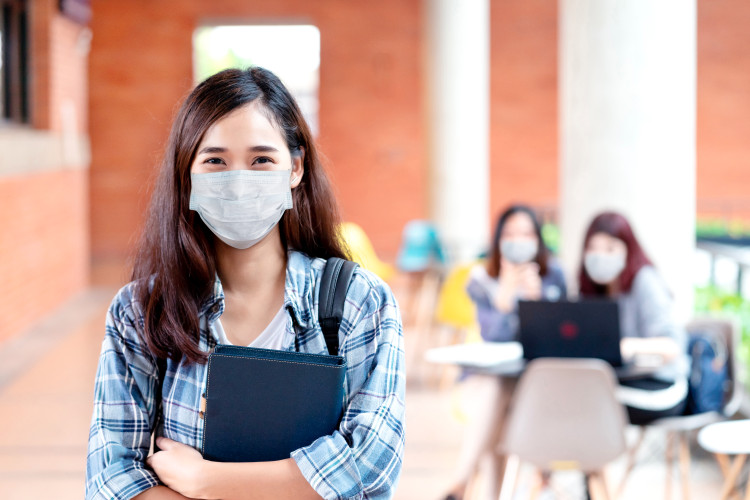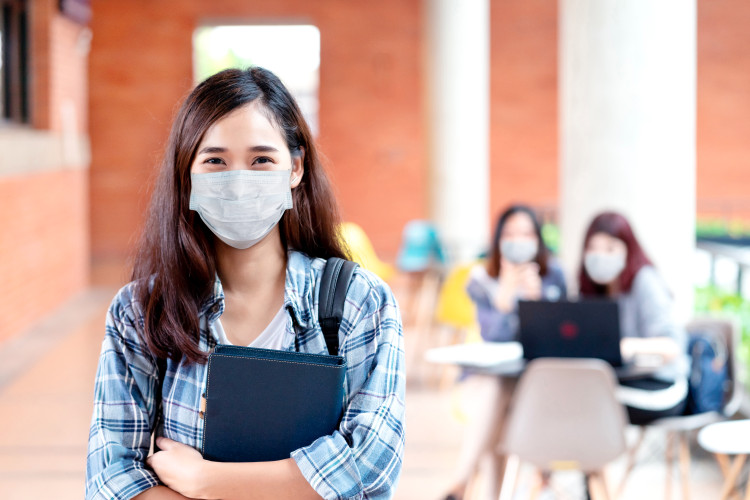College Student Wellness Guide for Remote Learners

The typical college life portrayed in movies and on TV became anything but in 2020. Whether living on campus or attending classes remotely, college students faced new challenges as federal, state, and local authorities reacted to health threats due to the spread of COVID-19. Going off to college has always been a time for traditional students to revel in their independence and discover who they are. These are a college student’s most social years, where they make contacts in their field and friends that can last a lifetime.

Staying healthy — both mentally and physically — during the pandemic has presented unique challenges to nontraditional students enrolled in online programs. Online students often experience additional pandemic-related stressors, such as helping others learn while they’re trying to study themselves and being isolated from family support.
While the pandemic has created additional hurdles for those working toward a degree, focusing on college student wellness can be a sound strategy. It can mean emerging with more than a college education. With the right resources, guidance, and discipline, college students can become better versions of themselves even during the pandemic.
How the pandemic changed the college lifestyle
Whether college students were ready or not, the COVID-19 pandemic thrust them into the unknown. At many schools, the on-campus experience has shifted to virtual online learning environments. In addition, students enrolled in online degree programs likely have many more responsibilities at home than before.
- Students have been forced to embrace remote learning due to pandemic safety protocols as campuses closed to slow the spread of the virus and ensure the safety of their students, professors, staff, administration, and surrounding communities.
- The abrupt shift to remote learning has been jarring to some students, especially those who perform at higher levels in collaborative environments among peers.
- Remote learning requires students to reach out to fellow classmates and professors, have self-discipline to ensure they stay on top of assignments, and reassess how to function effectively.
- Following social-distancing mandates, students often struggle to maintain opportunities for valuable in-person collaboration.
- Those working toward degrees online may struggle to limit distractions at home, without the option of safely studying elsewhere.
- It’s more difficult for traditional and nontraditional students to find valuable in-person internships due to pandemic precautions.
- The increased isolation some remote learners experience can lead to pandemic fatigue.
Building blocks for boosting college student wellness in the age of COVID-19
As students follow safe social-distancing guidelines, the pandemic has made connecting with family, friends, and fellow students more difficult. There is hope, however, in scheduling time and learning creative ways to stay connected.
Given the right set of tools, students can be better positioned to navigate this new world and overcome feelings of isolation and frustration. Focusing on college student wellness can help students emerge from the pandemic healthier, more centered, and able to mentor others who are faced with similar constraints.
- Self-care: Students learning remotely are reacquainting themselves with basic ways to care for themselves. Establishing and following a schedule, for instance, can prevent students from becoming overwhelmed with assignments and ensures they get enough sleep. Regularly exercising, eating nutritious foods, monitoring immune-depressing alcohol consumption, and managing stress are all important facets of consistent self-care.
- Safer socialization: Cautious socialization, rather than isolation, is healthy for college students. During the pandemic, students are discovering safer ways to keep up with family and friends and get together with others, such as in open-air environments and small groups.
- Online collaboration: Gone are the days of camping out in the library in large study groups to cram for tests or master difficult concepts and material. The pandemic has made group video calls, albeit more impersonal, a safer way to collaborate with others.
- Performance strategies: Students are looking for new strategies to earn good grades in the absence of face-to-face interactions. Reaching out to others or having regular check-ins with fellow classmates and professors helps students achieve better outcomes. Remaining positive and having confidence in the system and yourself results in increased opportunities for meaningful interactions.
Resources for boosting college student wellness
College students who are looking for ways to improve their wellness can find more information by exploring these links.
- Active Minds, “The Impact of COVID-19 on Student Mental Health” — Results of a survey of thousands of students about how the pandemic is affecting their mental health
- CNBC, “7 Ways the Coronavirus Pandemic Could Change College This Fall and Forever” — An exploration of the permanent changes in higher education as a result of the pandemic
- CNN, “Has Pandemic Fatigue Set In? Here’s Why You Might Have It” — A breakdown of the psychological aspects of pandemic fatigue
- Hackensack Meridian Health, “Why Routines Are Important for Mental Health” — How routines create rhythms and offer a sense of accomplishment
- The Conversation, “5 Things College Students Should Include in a Plan for Their Wellness” — Tips for college students struggling with feelings of isolation and limited job opportunities
Remote learners can thrive in a virtual world
College students should consider several health and wellness tips while taking classes online, whether they’re shouldering a full academic load or balancing college, work, and family responsibilities.
Exercise and fitness
Regular exercise and movement are key components to staying healthy and improving physical fitness and mental health. An added benefit of exercise during the pandemic is more resilient immune system function and reduced inflammation. Physical activity can even help reduce the severity of COVID-19 illness and enhance quality of life.
Students who are physically fit also tend to perform at higher cognitive levels, especially when following the recommended 150 minutes a week of moderately intense activity and at least two days a week of muscle-strengthening activity.
- Video streaming — Enables college students to enjoy increased access to fitness programs and explore new types of exercise during the pandemic.
- Connected group workouts — A variety of options ranging from simple Nintendo Switch games to pricier Peloton workouts help students connect with others despite distancing measures. Studies show that working out in a group can enhance the experience.
- Outdoor exploration — Allows students to take breaks from schoolwork and feel less isolated. Also, mood-boosting outdoor activities such as hiking do not require costly gear.
- Home equipment — Exercise equipment such as free weights, kettlebells, and resistance bands can help college students maintain their fitness while staying safe. Students without access to school gyms or fitness centers can find inexpensive and space-saving fitness equipment. It’s possible to balance indoor and outdoor aerobic activity as well as strength training during the pandemic.
Nutrient-dense foods
Focusing on highly nutritious foods is a key element of college student wellness. With the closure of many dining halls, college students have the unique opportunity to take the driver’s seat when it comes to their own nutrition. Students benefit from eating nutrient-dense foods while also avoiding high-calorie beverages.
What we consume influences our body’s natural defenses. Consuming foods that are nutritious and boost immunity, particularly during the pandemic, can help students stay healthy and fight off illness.
Stock up on nutritious foods that will last a week or so and avoid empty-calorie comfort foods such as cookies, chips, and ice cream. Low-nutrient, ultra-processed foods can drag down a healthy immune system. Strengthening the immune system is a key part of college student wellness, especially to combat COVID-19. To increase well-being, abstain from alcohol; cook your own food; limit grazing on snacks; aspire to eat a whole-food, plant-based diet; and boost your fiber, antioxidants, vitamins, and minerals.
Regular rest
Maintaining a routine that incorporates regular sleep schedules aids in both mental and physical wellness. Some 74% of students struggle to maintain a routine during COVID-19. A restful night of sleep helps our bodies recuperate and reduce anxiety.
Learning to function on just a few hours of sleep is traditionally part of the college lifestyle. However, achieving optimal levels of sleep is important.
If students must be on laptops, smartphones, and other devices close to bedtime, blue light blocking glasses can make it easier to get a good night’s sleep. During the pandemic, practicing good sleep hygiene involves establishing a relaxing bedtime routine, limiting caffeine before bedtime, abstaining from alcohol, and getting at least seven hours of sleep.
Stress management
Students can consume limitless amounts of information each day, but this can be detrimental. Without having a plan for managing stress, online learning can undermine college student wellness. Practicing yoga, meditation, and breathing exercises helps silence the mind and keep emotions in check. Incorporating stress-management strategies can help students overcome pandemic fatigue.
Lowering stress levels also can raise immunity-boosting T-cells and combat stress due to isolation and confinement. The pandemic posed a sudden disruption in the lives of college students, resulting in a loss of community, graduation ceremonies, sporting events, and beyond.
Virtual health resources
Students who are looking to stay healthy during the pandemic can review these resources.
- Clarity Clinic, “8 Ways for College Students to Stay Sane During the COVID-19 Pandemic” — Tips for navigating the pandemic, including creative ways to get your body moving
- Gallup, “Caring for Students’ Wellbeing in a Coronavirus World” — Ways for teachers to engage remote students, such as connecting virtually through FaceTime and video conferencing
- Nuvance Health, “Exercise Is Essential for Well-Being During COVID-19 Pandemic” — Suggestions for new fitness routines to improve physical and mental health
- World Health Organization, “Coronavirus Disease (COVID-19): Staying Active” — WHO guidelines on why and how to stay active during the pandemic
- Centers for Disease Control and Prevention, “Food and Coronavirus Disease 2019 (COVID-19)” — The latest CDC updates on food practices during the pandemic, including how nutrition can ease stress and boost immunity
Ensuring college student wellness for remote learners post-pandemic
The COVID-19 pandemic has accelerated the adoption of remote learning. Additionally, online education programs are anticipated to remain prevalent post-pandemic. However, there is some good news in all of this. According to a 2020 survey from Wiley Education Services, 78% of online students felt their remote learning experience was the same or better than their face-to-face education setting.
Learners who are changing and adapting to acclimate to their virtual college experiences can explore ways to improve their college student wellness, particularly through exercise, nutrition, stress management, and rest.

